I shrugged at this Harvey Weinstein–Joe Roth “please fire me” tape, which made its way around earlier this week. This is how colorful swagger types whose success partly depends on their ability to convince people every day that they fear nothing and no one….this is how guys like that talk. The bluster and the clubby attitude and vague air of entitlement. Most of them swear like sailors, and it’s kinda funny when they do.
I don’t live in these realms on a daily basis but time and again I’ve been in the room when such conversations have taken place. Twas ever thus.
Mudville Blues
It pains me to report this, but Hancock did a lot better yesterday than anyone was expecting — $18.8 million — and is now looking at $67 million for the weekend and $109 million cume for the five-and-a-half day July 4th holiday. It’s still not a major wowser — if Hancock was an earthquake-level hit it would be looking at a five-day haul of at least $120 or $130 million — but the $109 million cume means, as my numbers guy said this morning, “they got out alive.”
Dammit. I wanted to see Will Smith, Akiva Goldsman and Peter Berg punished (i.e., by seeing Hancock come up short in terms of expectations) for creating one of the all-time worst third acts in motion picture history.
Yesterday’s reporting about Thursday’s figures being flat encouraged me to think, “Okay, people are actually saying no to a bad film…the ticket-buying public is showing a little judgment here!” Not true, it turns out. Smith is such a big star that people will pay to see anything he’s starring in, including a film that sends you out staggering and gagging. They’re going for those first two acts, I suppose.
Who am I to talk, right? I paid to see it last Tuesday night.
Modifier
I don’t know what Barack Obama is doing now except making clear that he’s not a movement leader or a left-wing ideologue, but a crafty politician trying to appeal to the shmoes as well as the faithful who’ve been with him since ’07. He’s basically a liberal-minded centrist. He doesn’t seem to believe he knows everything or is absolutely right all the time. He seems to respect the idea of looking at things anew once in a while, to see how things may have changed or shifted around. That said, he’d better not overdo this move-to-the-center thing or he’ll piss off the lefties and then the press will start beating him up.
French Improvement
In his review of Guillame Canet‘s Tell No One, a superb French thriller that I finally saw this afternoon, New Yorker critic David Denby writes that he “realized I was very happy that everyone was speaking French. The reason is simple: an American version of this material would have had too many explosions and far too much violence in general, and it would have been similar to 30 other thrillers made here during the past ten years.”
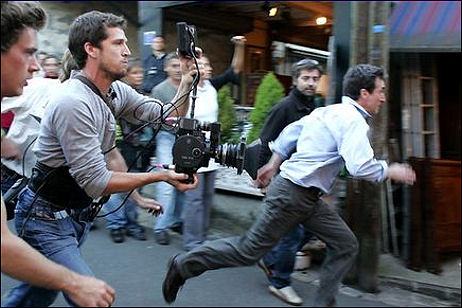
Tell No One director Guillame Canet (left, holding steadi…excuse me, a mojocam) shooting chase chase sequence with Francois Cluzet (right).
Truer words have rarely been spoken. It’s not that Tell No One, which involves murder, thugs, cops, gangstas, shootings, chases and the like, lacks thrills and intrigue. But it doesn’t brandish the cloddish brute machismo that you have to accept with if you’re going to watch a thriller made in this country.
American crime pics are about their stories and characters, sure, but they’re also about topping the last successful thriller in terms of visceral impact or stylistic panache. Their producers don’t want 15 year-old kids telling each other, “The shoot-out scene in that movie last month was a lot cooler.”
Tell No One is aimed at viewers who’ve had a year or two of college, read a book occasionally and have made it past the grand old age of 25. It plays its own game and sets its own standards. A little quieter, a lot smarter and much more riveting than…now I’m trying to think of a recent American murder-mystery I’ve really liked. It’s been a while.
Tell No One is based on an American mystery novel by Harlan Coben, but director Guillaume Canet, working with the screenwriter Philippe Lefebvre, “has set Coben’s material in a realistic social and working world where good-looking, intelligent, and articulate people find one another interesting,” as Denby notes. “La belle France! This emphasis on sociability is not unusual in French commercial filmmaking, but it’s virtually unknown in genre movies made here these days. There is violence — some of it startling, all of it significant — but that’s not what the movie is about.”
It’s also interesting as hell because the lead actor, Francois Cluzet, is almost a dead ringer for Dustin Hoffman, or rather Hoffman as he looked around the time of Rain Man, Family Business and Dick Tracy. It’s like watching Hoffman’s twin brother since he has a similar acting style, keeping the tension tucked inside but always radiating intelligence and paying close attention, etc.
It’s doubly fascinating that Canet puts Cluzet through a terrific foot-chase sequence in Paris, since it recalls the nocturnal running-through-Manhattan scene that a bare-chested Hoffman performed in Marathon Man.
Metropolis More
Five years ago Paramount Home Video put out a DVD of the “authorized restored version” of Fritz Lang‘s Metropolis, and everyone was happy. Here, finally, was the version film buffs could buy and take to bed. “At last we have the movie every would-be cinematic visionary has been trying to make since 1927,” said N.Y. Times critic A.O. Scott.
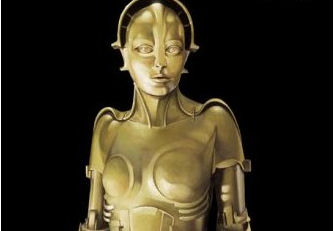
No longer. A near complete version of the film has been found in Argentina after a quarter of the film was believed lost for 80 years, a German film foundation announced two days ago. The extra footage runs an extra 25 minutes, and the 2003 DVD runs 124 minutes, so this new and presumably final version of Metropolis will presumably run 149 minutes, or just shy of two and a half hours. This is excellent new, of course, but I’ve seen Metropolis twice and I’ve never felt the absence of any vital narrative thread. I’m not a Lang scholar so what do I know?
Reminder
In this National Post piece about movie-theatre manners, author Michael Reid fails to mention one of the worst offenses out there — i.e, people claiming that nearby seats are saved without territorial jungle markings. Under-20s are the primary culprits. They’ll point to three, four or five seats and say, “Sorry, these are saved.” Not without markings they’re not!
As I explained last summer, everyone needs to adhere to “a basic Animal Planet view that you can’t ‘save’ seats without marking them like dogs and wolves and coyotes mark territory by urinating on the ground, or the way Alaskan gold miners stake claims with little piles of rocks in Henry Hathaway films.
“All you have to do is put something on the seat — a jacket, a magazine or an L.A. Weekly page, even a folded paper napkin. But you can’t just point to three or four seats (or six or ten seats…there has to be a limit) and say, ‘These are saved.’ Certainly not when the lights are going down. You can try this with one or two seats, maybe, but not with three.”
The next 17 year-old kid who says “sorry, these are saved” without markings is gonna have to lay it out with me.
Mexican Film Buffs Shafted
HE reader Alejandro Aldrete of Monterrey, Mexico, is angry that Disney/Pixar has sent only dubbed prints of WALL*E to local theatres, in contradiction of the usual-usual. I’m guessing that the Mexican distribution exec has probably decided that subtitles aren’t necessary for a kid’s film, and would certainly hurt business — brilliant.
“WALL*E arrived today in Mexican cinemas all over the country, and I believe in most of Latin America,” Aldrete writes. “I don’t know about the other countries, but apparently, even though today in my city of Monterrey, with nearly 5 million people and counting, and with WALL*E in hundreds and hundreds of theatres playing every hour from 10 am to midnight, I can’t find one single print of this film that isn’t dubbed into Spanish.
“Dubbing is common on Latin American television, but for the theatre run most films are subtitled. Only kiddie films get here dubbed to cinemas, and usually with one or two prints with subtitles. Yet in the last few years, animated films have stopped coming here with subtitles. Last year it was the same situation with Ratatouille, and even common people around here know it’s a crime against any film of that caliber to not be able to get seen as it is intended in it’s original version.
“My problem with Disney/Pixar on this is that they damn well know Pixar films have a special appeal to adults and film buffs. In the past with The Incredibles and Finding Nemo, I would go to a subtitled showing of those films and have a great time because I knew I was watching something ten times better than any dubbing they could come up with, and also because subtitled showings tend to have less kids fucking around and making noises. So it was a nice deal.
“I personally feel insulted and not taken into account as a loyal costumer of Pixar that they have decided to not bring here one single copy of WALL*E in it’s original form with original audio. Is it too much to ask that they send a bunch of subtitled prints to Latin America for the film buffs? The ones that will keep buying their films in 30 years? I mean really, how greedy can you be to think that you’re losing money by giving us one print in a hundred?”
Forget It
Meryl Streep is not going to be Oscar nominated for her performance in Mamma Mia!. Okay, possibly a Golden Globe nomination or win…maybe. But forget the Academy. However good or wonderful Streep may be in this upcoming ABBA musical, AMPAS members will stick to the straight and narrow and nominate for her Doubt, if they nominate her at all.
My perception is that Mamma Mia!‘s reputation went south with the hip crowd once the Hollywood Reporter‘s Ray Bennett flipped for it. That was it — the death knell. Those actresses playing the girlfriends of Amanda Seyfried going “oh…my…God!” were just icing on the cake.
Sardonic Bill
In his 7.2 piece about William Holden and the ongoing Holden retrospective at Lincoln Center (which goes until 7.15), Michael Atkinson hits the nail on the head in discussing the brusque anxiety and rattled melancholia that always simmered in the characters Holden played — there, obviously, because they defined Holden himself.
“Truth be told, Holden’s character-role capacities ranged only from narcissistic American jerk to self-loathing American lug,” he writes, “but his best movies are implicit inquisitions into that personality — like Sunset Blvd., Sabrina [and] Mark Robson‘s The Bridges at Toko-Ri.
“By the time of David Lean‘s The Bridge on the River Kwai (1957), a big-budget production looking for a disillusioned American Everyman sickened by his own lack of heroism needed only go to Holden.
“As Holden aged, his richest vein was the bitter personification of the costs of progress and the loss of frontier — he became, almost inevitably, the angry Old Guard facing melancholy supersession by the young, by modernity, and by the press of time.”
And yet Atkinson doesn’t mention Holden’s performance as Frank Harmon, a cynical L.A. real-estate agent in Clint Eastwood‘s Breezy (’73), which is part of the retrospective. Atkinson obviously thinks little of the film but his “angry Old Guard” comments about Holden fit Harmon to a T. Breezy is just pretty good — mature, straight, measured — but Holden’s acting lends a solid gravity force in every one of his scenes.
No Reason
Except that this 1940 title card has…I don’t know, a vibe. The starkness, the shadows, the monochrome sheen, the deco moderne lettering, the odd sideways markings on the road, the fake authenticity of it.

Da Numbahs
Fantasy Moguls‘ Steve Mason is reporting that even though Will Smith, Akiva Goldsman and Peter Berg‘s Hancock was “flat” from Wednesday-to-Thursday with an estimated $17.1 million and a 2 1/2 day cume of just over $41 million, it’s nonetheless on target for $100 million over the 5 and 1/2 day holiday weekend. But I say no to that.
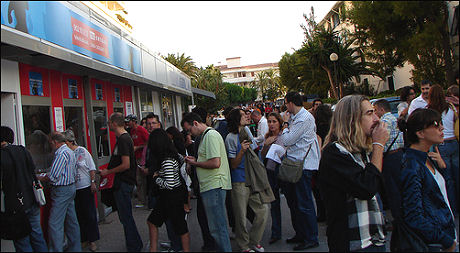
The truth is that Hancock‘s ticket sales yesterday should have been more than its Wednesday business, which was estimated at $17.3 million. Instead it did $17.1 million — flat-ass. A movie that’s really happening with the public would have jumped to $19 or $20 million yesterday. This tells you the word on the street (i.e., that the third act is an out-and-out disaster) is probably catching up with it.
July 4th is always a dead day, so Saturday’s business will tell the tale. But I’m figuring Hancock will do $80 to $90 million by Sunday night. And if this happens, anyone who reports that figure as an absolute box-office triumph will be less than honest in their assessment. Not that $80 to $90 million is anything to sniff at. It’s just that you can’t expect sales to be rocket-ship historic if the dogs don’t like the dog food. If you make a movie that goes completely insane and blows itself up in the third act, sooner or later people will realize this and respond accordingly.
Kit Kittredge, sad to say for Picturehouse/NewLine, is a flat-out disaster. It did about $1.1 million on Wednesday in 1700 theatres, averaging $600 a theatre. And it $900,000 on Thursday for a $500 per theatre average. Complete wipe-out. Mason pussyfoots by saying it’s “unlikely to top $10 million” by Sunday night. Gee, do ya think so?
Lose Your Mind
Seeing Hellboy II the other night reminded me that the films of Guillermo del Toro are as good as it gets in the fantastical horror realm. They’ve got first-class effects, wit, invention, soul, visual economy, emotional gravitas. The monsters are beautifully particular, the performances have warmth and authority, and the camerawork and the cutting are grabby and fast but this side of hyper.
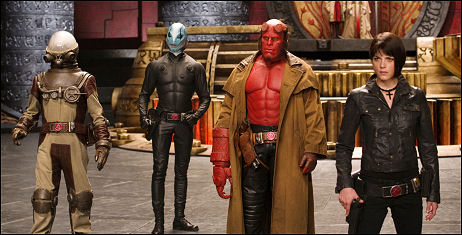
The problem is this, and it’s not so much Guillermo’s fault as the action-fantasy genre: I’m sick to death of watching stuff getting wrecked and smashed and shattered and blown into a million pieces. I hate the rigid big-studio FX formula that insists upon confrontation and chaos and ruination happening ever 20 or 30 minutes, like some stupid whammy chart. Windows exploded, buildings decimated, cars doing aerial triple-flips, fire hydrants spewing tons of city water, industrial clutter everywhere….what the fuck is this? It’s the same shit in every movie, and it vacuums your soul.
What kind of cretin do you have to be to find this stuff interesting after it’s been repeated 25 or 30 times? How many times can the dumbest moviegoer out there go “whoa!” after seeing a super-hero wallop a slime-covered monster and send it flying several hundred yards into a building or a wall of glass or a concrete bunker, or vice versa? How many times can the hero take a severe beating to the extent that it looks like he’s finished? How many times can a slithering disgusting alien creature try to eat or invade or flatten the heroes? How many times can a moron with a extra-large tub of popcorn in his lap be impressed with loud aural thumpings on the soundtrack?
Guillermo does everything he can to add feeling and humor and humanity to Hellboy II, and he succeeds nicely from time to time, but he’s working within a genre that insists upon showing the same shit over and over, no matter what and no end in sight.
I never thought I’d say this, but in this context I’m a Barry Manilow type of guy. I mean that I loved (okay, liked) the sequence in which Ron Perlman‘s Red and Doug Jones‘ Abe Sapien drunkenly sing along to Manilow’s “Can’t Smile Without You.” And I’m a pretty big fan of Tecate beer. And I liked the bit with Perlman protecting the baby from the madness and other stuff along these lines.
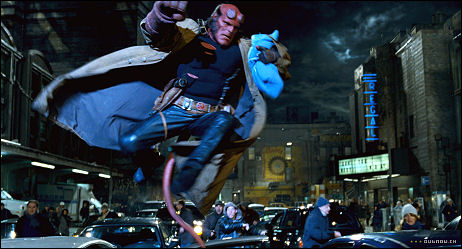
I’d much rather see a televised dramedy series starring Red, Abe, Selma Blair‘s Liz Sherman, Jeffrey Tambor‘s Tom Manning and all the rest of the Del Toro freaks and eccentrics, and made into a kind of Everybody Loves Raymond type deal with monsters showing up maybe once every five or six episodes. If that. Because I really can’t stand watching shit being blown up any more. How can people can sit through the same demolition derby in film after film, over and over, year after year? It’s insane.
Guillermo knows that I’m much more of a Chronos/Devil’s Backbone/Pan’s Labyrinth/The Orphanage type of guy and that I just can’t roll over for the big-studio stuff. It’s always been a big problem for me.
One technical beef: when the giant land-squid monster picks up a Mercedes Benz and squeezes it to death, we should see gallons of gasoline gushing out. Are we supposed to think that the car had no gas in it? I didn’t believe it. Maybe Guillermo can fix this effect for the DVD version.

